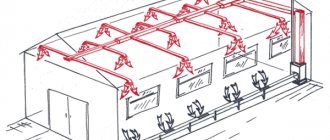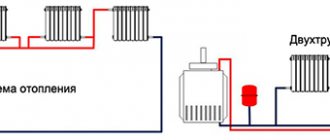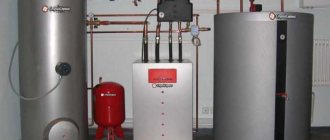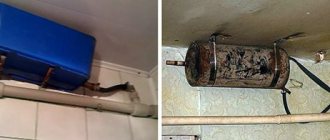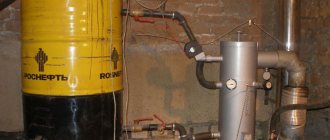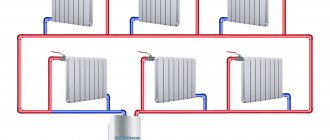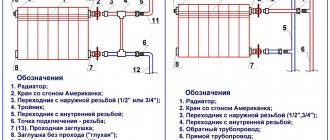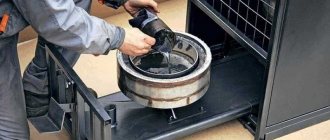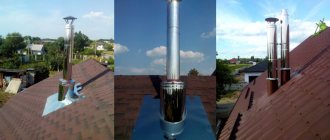A heated greenhouse is an opportunity to get a good and abundant harvest all year round. When considering heating industrial greenhouses, owners cannot always apply the methods in private households. Let's figure out what devices will be appropriate in small-format greenhouses suitable for placement on your own lands, and what equipment is suitable for heating large areas. We will also consider the step-by-step installation of various types of heaters with the ability to do the work yourself.
Methods for heating greenhouse areas
Heating is installed in greenhouses for year-round use or for early spring planting of crops and flowers.
The following types are considered the most effective heating methods:
- stove heating with a water-air circuit;
- heating line from an electric, gas or solid fuel boiler;
- use of gas-type heat guns;
- convector or infrared circuits powered from the mains.
Warming up with gas guns is considered effective. The air heats up quickly, fuel consumption is low, the unit itself is compactly located and, if chosen correctly, is absolutely safe to use. If the greenhouse is heated with electric heaters, experts recommend using infrared devices. Infrared rays heat the soil and plants without drying out the air.
Important! Convectors heat the air so that the lower root part of the plant remains cold, and the upper part remains excessively warm. This system is not recommended for permanent use; it is used as a temporary measure to quickly heat the upper part of the greenhouse.
Methods for heating agricultural structures
When deciding how to heat a greenhouse, you need to remember that most of the thermal energy enters this structure naturally - from sunlight passing through polyethylene, polycarbonate or glass.
In this way, for example, heating of greenhouses (small in area) is organized. Only a small heater can be installed there, turned on on particularly cold or cloudy days.
Solar energy is most often sufficient to heat a greenhouse.
However, large indoor structures for growing plants necessarily require additional heating. Let's take a closer look at how heating can be arranged in a greenhouse with your own hands.
Method 1. Using electrical energy
This type of energy carrier is quite common, effective, but not always economical. To avoid excessive spending, you need to choose the right heat source.
The following varieties exist:
- Radiators . A fairly effective way to maintain the air temperature necessary for plants. Excellent for small greenhouses, when only short-term heating is needed (otherwise this option will not be economical).
If you intend to grow crops not only in early spring, but also in winter, it is advisable to purchase fan heaters along with radiators. They allow you to quickly raise the temperature and prevent the formation of condensation on the walls of the structure.
The photo shows electric heating radiators installed in a greenhouse
Choose modern models of electric radiators and fan heaters, using which you can precisely regulate the amount of heat produced. In addition, their specially shaped heat exchangers heat the air more evenly and, thanks to convection, organize its circulation throughout the entire greenhouse space.
Note! During the installation of electrical equipment, safety instructions must be strictly followed, since due to the increased air humidity in the greenhouse there is a great danger of electric shock.
- Cable heating . This method is similar to the well-known “warm floor” system, which is installed in homes. For its arrangement, special electrical cables are used.
Their installation is carried out as follows:
- part of the fertile soil layer is removed;
- a heat-insulating material is placed at the bottom of the resulting pit, which will prevent unproductive heat consumption and protect the electrical cable from mechanical damage;
- after this, a layer of fine-grained sand is poured;
- the cable is laid on the sand;
- The previously excavated soil is backfilled on top.
Cable laying diagram for heating indoor agricultural structures
The advantages of such a solution are obvious:
- economical energy consumption;
- the ability to accurately regulate the temperature thanks to thermostats;
- uniform distribution of thermal energy over the entire area of the greenhouse;
- low time and money costs for equipment installation.
- Infrared emitters . This is one of the new heating methods that is often used in greenhouses covered with polycarbonate sheets.
Setting up such a system is as simple as possible: just buy and install a certain number of heating devices in the right places.
- This method of heating air in a greenhouse has many advantages:
- improving the germination of seeds sown in the ground;
- the ability to organize zones of intense and weaker heating within one room (for example, separately for seedlings and already planted plants);
- long service life of purchased wires;
- economical consumption of electricity.
Infrared emitter for heating plants
- Heating using liquid coolant . It is quite difficult to assemble water heating for a greenhouse with your own hands, but its efficiency is worth the effort. The liquid can be heated either using a special boiler (for example, induction) or in a boiler. It is only important to correctly arrange the heating radiators and organize circulation, for which a water pump mounted on the return pipeline is perfect.
Scheme of arrangement of water heating of a greenhouse
Method 2. Using gas
This type of energy carrier is the most economical. But it requires connection to the main gas network, and this procedure has many obstacles that not everyone can go through. We are talking, first of all, about obtaining all the necessary permits for the installation of gas equipment.
Bureaucratic red tape can be avoided by using liquefied gas. However, with its help it is impossible to heat the greenhouse throughout the year, since this requires too frequent replacement of cylinders (or installation of a personal gas holder).
A convector running on liquefied gas can be used to heat the greenhouse.
Remember that the use of gas equipment requires the installation of supply and exhaust ventilation, which ensures access of fresh air to the agricultural structure and removal of combustion products, which can be dangerous.
Method 3. Using solid fuel
Greenhouse heating stoves using wood, fuel pallets, pellets or coal are very common for heating both individual greenhouses and large structures typical of farms. Such systems are especially popular in suburban areas, where people do not lack firewood.
Wood burning boiler used to heat a greenhouse
Solid fuel boilers do not require permits before installation and are easier to install. They are characterized by slightly lower efficiency than the previously discussed devices, as well as difficulty in management. Agree, it is difficult to regulate the temperature in a greenhouse that is heated with wood.
Also, such stoves require constant human attention. On dark, cold winter nights, you will have to periodically add firewood to the firebox, otherwise the death of the much-anticipated harvest cannot be avoided.
Advice! For solid fuel boilers and stoves, it is advisable to use high-quality firewood or coal. Otherwise, the efficiency of the heating equipment will decrease even more.
The advantage of the described method is the possibility of self-installation of heating equipment. With some plumbing or construction skills, you can design a heating stove yourself.
Method 4. Using organics
From a school biology course, everyone knows that waste products of animals (as well as humans), as well as the remains of wood and other plants, emit heat when rotting. Moreover, this process, which is caused by the vital activity of bacteria and other microorganisms that feed on decaying organic matter, continues for a fairly long period of time.
Manure is an environmentally friendly fuel for a greenhouse
Therefore, it is advisable to heat a small greenhouse in this way. One addition of organic matter is enough for 3-4 months of heating, which is quite enough to help plants survive frosts.
You need to add “organic fuel” as follows:
- Manure, peat or organic matter that was stored in your compost pile must be thoroughly dried, formed into briquettes and stored. 7 days before placing it in a greenhouse or greenhouse, the humus must be re-moistened and loosened.
The appearance of steam will indicate the beginning of the life process of microorganisms. This will serve as a signal to add “fuel” to the greenhouse.
- The thickness of the layer being laid depends on the area of the greenhouse and the number of days remaining before the onset of stable heat. As a rule, 30-60 cm is enough. If you add chopped straw to the manure, the heating duration can be extended, but the temperature of the heated soil itself will decrease.
- Soil is poured on top of the manure, which is necessary for plant growth.
Scheme of laying manure for heating a greenhouse
Advice! This method can be combined with those described above. So, you can save a significant amount of electricity, gas or firewood.
Stove heating
Ovens for greenhouses are made of brick and metal. Brick structures are considered more practical, since the material itself heats up slowly and gives off heat just as slowly, which means you can save a lot on fuel consumption. Metal structures warm up quickly, but with the reduced heat capacity of the material, they require constant fuel supply.
Metal stoves
The devices are suitable for seasonal use due to the following features:
- mobility - structures are easy to install in the spring and remove in the summer;
- light weight does not require foundation construction;
- compact dimensions allow you to install the stove in limited space;
- when choosing the right model, it is easy to connect a circuit with a coolant liquid;
- the price of the devices is affordable;
- installation and startup are carried out on your own without much difficulty.
The disadvantages of the units include the lack of automatic control and drying of the air. You will have to install a container of water in the greenhouse to maintain the humidity at the desired level.
It is not difficult to install heating in a greenhouse with your own hands; just install the stove in a utility room or vestibule, and bring a circuit with water or air coolant into the greenhouse. The chimney can be discharged into a greenhouse, placing the pipe at an angle of 15 degrees; the heat from the chimney will serve as additional heating if the pipe is also made of metal and there is no insulation. But if the chimney is vented outside, it will have to be insulated to reduce heat loss.
Important! Installing a metal stove requires a strong frame to prevent distortions or collapse of the structure - this will lead to a fire.
The most popular types of metal stoves:
Purpose and principle of operation of a hydraulic arrow for heating
- Vesuvius mini. A potbelly stove with a simple design and low cost. A thermal power of 4 kW is enough to warm up 80 m3, that is, a greenhouse with an area of up to 30 m2. Heat with wood, the top panel is suitable for heating water.
- Cinderella. Small-format metal stove with side convectors distributing heat flows. Power 6 kW, heats up to 60 m2. The fuel is solid, there is a burner on the top panel.
- Teplodar Pechurka plus. A 5 kW model will heat up to 50 m2 of area. There is a casing with convection holes that guarantees uniform heat transfer. Heat with wood, there is a burner. Light weight and size, increased stability are advantages.
Important! When choosing a unit, you need to pay attention to the power and functionality of the device.
Step-by-step installation technique:
- preparing a base of durable material, for example, paving slabs in the center of the greenhouse;
- install the unit, checking the convenience of loading fuel and cleaning ash;
- if the greenhouse is equipped with a permanent wall, the stove is placed against it, turning the unit with the back wall towards the wall panel;
- connect the chimney to the smoke pipe, seal the connection with heat-resistant sealant;
- connect the water and air circuit.
Important! The chimney connection is carried out according to the diagram attached to the device. Starting a system with a water circuit without filling the line with coolant is not allowed.
Brick ovens
Brick stoves are used in greenhouses for year-round use, are able to maintain heat in severe frosts, and have a high heat capacity.
To create heating for a greenhouse with a wood-burning boiler with your own hands you will need:
- ceramic solid brick 220 pcs.;
- fireclay bricks 80 pcs.;
- laying solution with clay 80 l;
- fireproof laying solution 30 l;
- concrete for foundation 0.25 m3;
- grate, combustion chamber, blower and cleaning doors, smoke valves;
- tools for laying out mortar;
- tape measure, pencil, level, suspension.
You can take the drawing as a basis. In the diagram, the height of the stove to the beginning of the chimney is 2.15 m; the structure is placed in a standard-sized greenhouse. Horizontal dimensions 51x77 cm.
Step by step construction:
- To fill the foundation, remove soil up to 40 cm thick from an area of 70x100 cm. Cover the bottom of the pit with sand to a depth of 20 cm, then install plank formwork, lay reinforcing bars with a diameter of 12 mm in a double-row lattice with a step of 20 cm. Mix the concrete mixture and pour it onto the prepared structure. Drying the foundation requires 3 weeks with regular moistening of the surface.
- You need to start laying out the ash pan and the firebox according to the diagram. The first 4 rows are red brick using clay mortar. Installation of the ash pan door requires fixing it with wire in the masonry itself. Rows 5-12 – fireclay bricks with refractory mortar. The grate is mounted in the 5th row, the fire door is installed in the 6-8th rows, the 9th-12th row is the arch of the firebox.
- Rows 13-15 - fireclay bricks, and in row 15 install a cleaning door. From the 16th row the laying out of red bricks, and in the 16th row the installation of the cleaning door continues, and the 17th-21st rows form smoke channels. In row 22 you need to install the first smoke damper.
- Rows 23-27 are a continuation of the smoke channels, in 28 you need to lay out a narrowing, and in 29 you need to put a second smoke damper. Rows 30-31 - furnace roof, starting from row 32, a chimney of the required height is laid out from 4 bricks with ligation.
To clarify all the nuances, watch the video.
We use water for heating
You can create water heating for greenhouses with your own hands. You heat water in a boiler or boiler, connect plastic pipes to it, which you run along the entire greenhouse premises. Water circulates through the pipes thanks to a special pump. Moreover, the pipes can be laid not only along the walls of the greenhouse, but also dug into the ground, thus ensuring the heating of the earth.
The advantages of water heating are the same as air heating: it is quick and easy to create and does not require large initial costs for materials.
The disadvantages are also similar: high heat loss (since the heat carrier is still air, and tubes dug into the ground can only increase the temperature by no more than 10 degrees). Another drawback is added - high energy consumption for constant heating of such a quantity of water.
Conclusion: A common greenhouse heating scheme today. If you are building a greenhouse with your own hands and do not have a large initial amount to purchase equipment.
Greenhouse heating water
A water heating scheme for a greenhouse can be organized by connecting the greenhouse to the centralized heating system of the house or by installing a separate boiler.
If a tie-in is formed into the main line of the house, it is recommended to build a separate circuit for subsequent drainage of the coolant. A gas, electric, solid fuel or universal type device is selected as a separate boiler. Air-to-air heat pumps for heating a private home
It all depends on the capabilities of the owner and the features of the units:
- Gas equipment is considered economical and convenient. Automatic control system makes operation easy. The coaxial chimney does not heat up.
- The solid fuel boiler runs on wood, coal, and pellets. Inexpensive fuel is a plus, low level of automation is a minus.
- Electric boilers are compact, noise-free, and automated. The high price is a minus, as are increased energy costs.
Important! To reduce fuel costs, it is recommended to install storage tanks. In the case of an electric boiler, a two-tariff meter with the ability to fully load the system at night.
Rules for choosing a boiler:
- Selection of equipment power based on the greenhouse area and required temperature.
- If there is a gas main nearby, it is more profitable to equip gas heating for industrial greenhouses and private greenhouses. In the absence of a main line, for greenhouses with an area of 50 m2 or more, it is more convenient to install solid fuel boilers; the costs pay off in 1-3 years. In small-format greenhouses it is more convenient to install electric boilers without a special chimney; energy costs will be low.
An important point is the calculation of greenhouse heating. For rooms up to 3 m high, calculations are carried out by area using the formula S = a*b, where:
- S – area in m2;
- a, b – length and width in meters.
To determine the thermal power, the formula P = S*120 is used, where P is the indicator of the calculated thermal power in W, S is the area in m2. To determine the number of battery sections, use the formula n = P/p, where n is the number of sections in the radiator of the desired type, and p is the thermal power of one battery section (indicated in the data sheet). The final figure for the number of sections must be evenly distributed over the entire area of the greenhouse, dividing them into several batteries.
Important! For a greenhouse, you should choose radiators of small height to warm up the root space.
To equip the heating of a polycarbonate greenhouse in winter using water heating, you need to purchase all the components, which include a pump, pipeline, radiators, safety group, expansion tank, valves.
When installing a solid fuel boiler, a heat accumulator will be required. To understand the heating circuit connection diagram, watch the video.
Step-by-step installation of water-type heating:
- Install the boiler. A vestibule is formed for solid fuel equipment; gas and electric boilers can be installed in a greenhouse. Installation depends on the type of boiler - suspended, floor-standing (a solid base is required).
- Connect the unit to the chimney. It is better to connect solid fuel boilers to a sandwich chimney according to the diagram. Electric boilers do not need a chimney. Gas boilers are connected to a coaxial chimney discharged through the wall in the boiler installation area.
- Connect batteries that are hung on the walls. Install a Mayevsky tap and valves for draining and shutting off the coolant on each battery. Heating schemes for greenhouses are selected depending on the convenience of connecting radiators; this can be a bottom or top connection. The pipeline is formed from pipes with a diameter of 20-25 cm.
- All water heating systems for greenhouses require the installation of an expansion tank. It is better to take membrane equipment in the form of a sealed container with good compensation indicators. The tank is installed at any point, for example, immediately after the outlet pipe from the boiler or in front of the circulation pump installation area. Connection from below through a valve.
- A safety group consisting of a pressure gauge, safety valve, and air vent is installed after the outlet pipe from the boiler.
- The circulation pump is installed on the return pipe in front of the inlet pipe to the boiler. A coarse filter is installed in front of the pump.
After assembling the system, it is filled with coolant and run in test mode. Pressure testing allows you to identify problems with low tightness and is carried out with preliminary closing of the Mayevsky taps and connecting the compressor. Use a compressor to pump up the pressure indicated in the technical data sheet of the boiler and radiators. After setting the pressure parameter, the integrity of the system, joints, and components is visually assessed. If there are leaks, fix them, then put the system into operation with preliminary balancing using Mayevsky taps.
On a note! Gas and electric boilers can be immediately supplemented with an expansion tank, pump, and safety group. These types of equipment are more expensive, but easier to install and assemble.
We use the energy of the sun
To build a structure, choose the most open area on the sunny side. Build a greenhouse from transparent materials (glass, film) to allow free access of sunlight to plants and soil. They will heat the greenhouse. To achieve the maximum effect of this type of heating:
- Use solar batteries. You can buy them, or you can make them yourself from plastic bottles or tubes. The storage liquid is ordinary water, which will retain heat longer than air.
- Cover the greenhouse with film in several layers.
- Ensure heat accumulation in the soil. When building a greenhouse, go 15-20 cm down and cover the ground with several layers of waterproofing film. Spread coarse wet sand evenly over the decking.
- The greenhouse design is preferably semicircular with an arched vault. This shape reduces heat loss in the room.
- Provide protection from drafts. Choose a windless place for the greenhouse, build protective structures around it from the winds. This will help maintain temperature.
The place for the greenhouse is at sunrise. The longer the air and soil in the greenhouse warm up during the day, the longer and better the heat will remain at night. The advantages of solar heating are availability and cost-effectiveness. This is the cheapest, almost free greenhouse heating scheme.
The disadvantages of this method are the low efficiency of the sun and large heat losses in late autumn and winter. With such a heating system, it is impossible to ensure a stable soil temperature around the clock, which many plants require.
Conclusion: Suitable as a single system only for the spring-summer period. In winter greenhouses, it is recommended to use it only as an auxiliary to the main heating method.
Heating the greenhouse with electrical appliances
If you need a greenhouse with heating yourself, the circuit of which can be implemented without any problems, IR heaters are used. To calculate the number of devices, the formula is taken - for 10 m2 of area you need 1 kW of power. The units are evenly placed throughout the greenhouse, suspended from the frame on brackets and connected to the power supply.
On a note! To automate heating, you should connect temperature sensors, placing them at a height of at least 100 cm so that they are not exposed to light from heating devices.
Gas heating of the greenhouse with an infrared heater
Gas heating of a greenhouse today is one of the most promising and economical heating options with minimal impact on the microclimate. This is explained by a number of features of this type of greenhouse heating systems in winter and, if necessary, in summer. Gas can be used as fuel in an air heating system and successfully provide heating of a greenhouse with an infrared heater without the risk of air pollution by combustion products or a critical impact on humidity.
The operating principle of such heating is quite simple - it involves one way of delivering heat to plants and soil and two ways of distributing heat throughout the system. If radiation from infrared sources is used to directly heat the greenhouse, it can be obtained in two ways:
- burning gas in a combustion chamber outside the greenhouse and directing hot combustion products to circulate through pipes indoors;
- burning gas in local emitters and discharging combustion products through pipes with a vacuum suitable for each burner.
The first method involves laying emitter pipes under the ceiling, through which a constant flow of air heated from the combustion of gas passes. Pipes with certain characteristics take heat from the gas-air mixture and direct it down to the plants and soil, creating uniform heating.
The second option is more suitable for growing crops and poultry. Gas is supplied to the burners of the emitters, which can be located in lines on the combustion product exhaust pipe. A heated burner with a reflector directs radiation down to a small area, the gases are discharged through a pipe with a vacuum, while each burner can be controlled separately, and the entire system can change the height of the suspension and the intensity of the directed radiation.
Infrared heaters for greenhouses create controlled and directed thermal radiation that does not harm plants, warms the soil and equipment of the greenhouse, and combustion products and moisture generated during operation of the burners do not enter the air. In terms of its effect on the microclimate, the infrared heater system for greenhouses is optimal - it provides heat, but does not distort other parameters vital for plants. Unlike electric heating, it is much cheaper to operate.
It is impossible to use home-made equipment to create such a system - it is dangerous and not justified economically and technologically. There are infrared gas equipment systems developed by serious manufacturers for heating greenhouses with optimal technical and economic parameters.
Heat sources
So, what can a heated greenhouse use as a heat source?
Central heating
If there is a heating main at a short distance from the greenhouse, the obvious solution is to connect to it. The classic water heating scheme with convectors or registers mounted parallel to a single-pipe filling system will be relatively inexpensive.
However, cheap central heating at the implementation stage will mean quite high operating costs. The price of thermal energy obtained from a thermal power plant necessarily includes the costs of repairing and laying heating mains, unnecessary heat losses during transportation, staff salaries, contributions to the state budget, and much more.
READ ALSO: How to make a greenhouse with your own hands: avoiding annoying mistakes
Boiler room
One way to significantly reduce overhead costs is to build your own boiler house. In this case, costs are reduced to the purchase of fuel and routine repairs of equipment.
What can burn in a boiler?
- Natural gas . The cheapest heating for a greenhouse is gas; however, this is only possible if there is a highway at a short distance from the greenhouse. Many regions of the country are still not gasified.
Modern block-modular gas boiler house.
- Fuel oil . Being a by-product of cracking oil, it is flammable and inexpensive compared to gasoline or diesel fuel.
- Coal . In modern boiler houses, the services of stokers are dispensed with to load it: fine-grained coal is dosed out from the bunker.
- Wood processing waste . Sawdust and wood chips are excellent fuel; Moreover, they are more than inexpensive.
However, with all its advantages, your own boiler room in a greenhouse is not the most economical heating method.
There are several reasons for this.
- Some heat is inevitably lost during transportation. Of course, the losses are less than on the way from a remote thermal power plant, but they exist.
- For the boiler room you need to build a separate room, which is not cheap.
- Finally, the very concept of water heating implies repeated transfer of thermal energy:
- from combustion products - to the heat exchanger;
- from the heat exchanger - water or other coolant;
- from it - to radiators or registers.
They, in turn, heat the air, which, when circulating, heats the soil and the plants themselves in the greenhouse. And at every stage, losses are again inevitable.
READ ALSO: Growing in a greenhouse: how to harvest throughout the year
The traditional water heating scheme is associated with large non-target heat losses.
Electricity
Traditional heating of a greenhouse with electricity - using a heating element water heating boiler or air heaters - is quite an expensive undertaking. To estimate the scale of costs, it is enough to perform a simple calculation.
With a greenhouse size of 20x50 meters and an average height of 4 meters, its total volume is 20x50x4 = 4000 cubic meters. With a heat demand of 150 watts per cubic meter, 600 kilowatts of thermal power are needed to heat the room. Since the efficiency of any direct heating electric heating device is 100 percent, this will result in the same 600 kW of electrical power.
Now let's calculate the average monthly expenses at the cost of electricity at 3.5 rubles per kilowatt-hour.
- 24x600=14400 kilowatts of electricity are consumed per day.
- Per month - 14400x30=432000 kilowatt-hours.
- Expenses will amount to 432,000 x 3.5 = 1.512 million rubles.
It is unlikely that the harvest from the heated area will cover the costs, not to mention the profit.
An electric heater is a solution that is cheap only at the installation stage.
Let us clarify: the average actual electricity consumption is usually much less than the calculated one, so we are exaggerating the picture a little. On sunny days, the greenhouse will spend several times less electricity on heating.
However, there are two loopholes that can significantly reduce costs.
Heat pumps
This is a whole category of devices that consume electricity not to generate heat, but to move it from a colder object to a warmer one.
Different environments can serve as a source of low-grade heat.
- Air-to-air heat pumps are the most structurally simple devices. A typical example is a regular household air conditioner. The fan blows outside air through the heat exchanger, cooling it even more; the air in the room is heated in a similar way. The cost of such devices is relatively low, but the operating temperature range is quite limited. The best examples of air source heat pumps operate only at -30 degrees (in particular, this is the minimum operating temperature of the most popular Mitsubishi Zubadan pumps), while in many regions of Russia the thermometer drops to -40-50 degrees in winter.
READ ALSO: Roofing materials from the manufacturer Agrikol
Characteristics of an air source heat pump.
- Ground-air and ground-water are schemes that involve the use of geothermal heat. Heat exchanger probes are immersed in vertical wells up to hundreds of meters deep. An alternative solution - laying a horizontal collector in the ground - requires a large area, which is not always acceptable.
- Finally, water can also serve as a source of heat. The heat exchanger is placed in a non-freezing reservoir and pumps thermal energy from there.
The difference between the energy expended and the heat produced reaches five times in the best heat pumps.
Infrared radiation
Infrared heating of greenhouses also allows you to significantly save heat. Due to what? After all, infrared heaters for greenhouses are typical direct heating devices, aren’t they?
The point is a more rational distribution of heat. Emitters - reflectors with quartz high-temperature heaters or ceramic panels - are mounted on the ceiling. Thermal radiation directly heats the leaves, stems and soil.
As a result, at a room temperature no higher than +5 degrees, plants and the soil under them can be heated to the optimal +25 C.
An important point: the emitters are mounted at a height of at least three meters. The instructions are due to the fact that plants can receive serious burns at a short distance from the heating element.
The photo shows an infrared heating system in an industrial greenhouse.
Stoves are the best way to use solid fuel heating in winter
To save heating costs in winter, solid fuel heat generators are a profitable solution. With their help, you can heat industrial and farm greenhouses with an area of up to 1000 sq. m. They are also used for summer cottages, designing the system in such a way that heating occurs in the living space and the greenhouse installation simultaneously. When installing such heat generators, it is important to follow all necessary safety rules.
The fuel is used depending on the type of heat generator; the best option is considered to be universal models that are suitable for logs, pellets, coal and other things.
Our company will help in designing and installing the best method of heating in winter for an industrial, farm or other facility.


